Case Study: Pathophysiology and Nursing Strategies for Heart Failure
VerifiedAdded on 2022/10/04
|7
|1600
|240
Report
AI Summary
This report analyzes a case study involving Mrs. Brown, diagnosed with an acute exacerbation of chronic heart failure. The first section delves into the pathophysiology of heart failure, explaining the mechanisms behind the condition, including neurohormonal responses, the role of the sympathetic nervous system, and the renin-angiotensin-aldosterone system (RAAS). It highlights the impact of factors such as hypertension, narrowing of arteries, and hypoxia on the heart's function and blood pressure. The second part of the report focuses on nursing strategies, prioritizing the management of hypoxia and shortness of breath through the Fowler position and oxygen therapy. It also emphasizes the importance of providing assistance with daily activities and offering psychological support to the patient, based on evidence-based practices. The report references several research studies to support the analysis and the suggested nursing interventions, providing a comprehensive overview of the condition and its management.
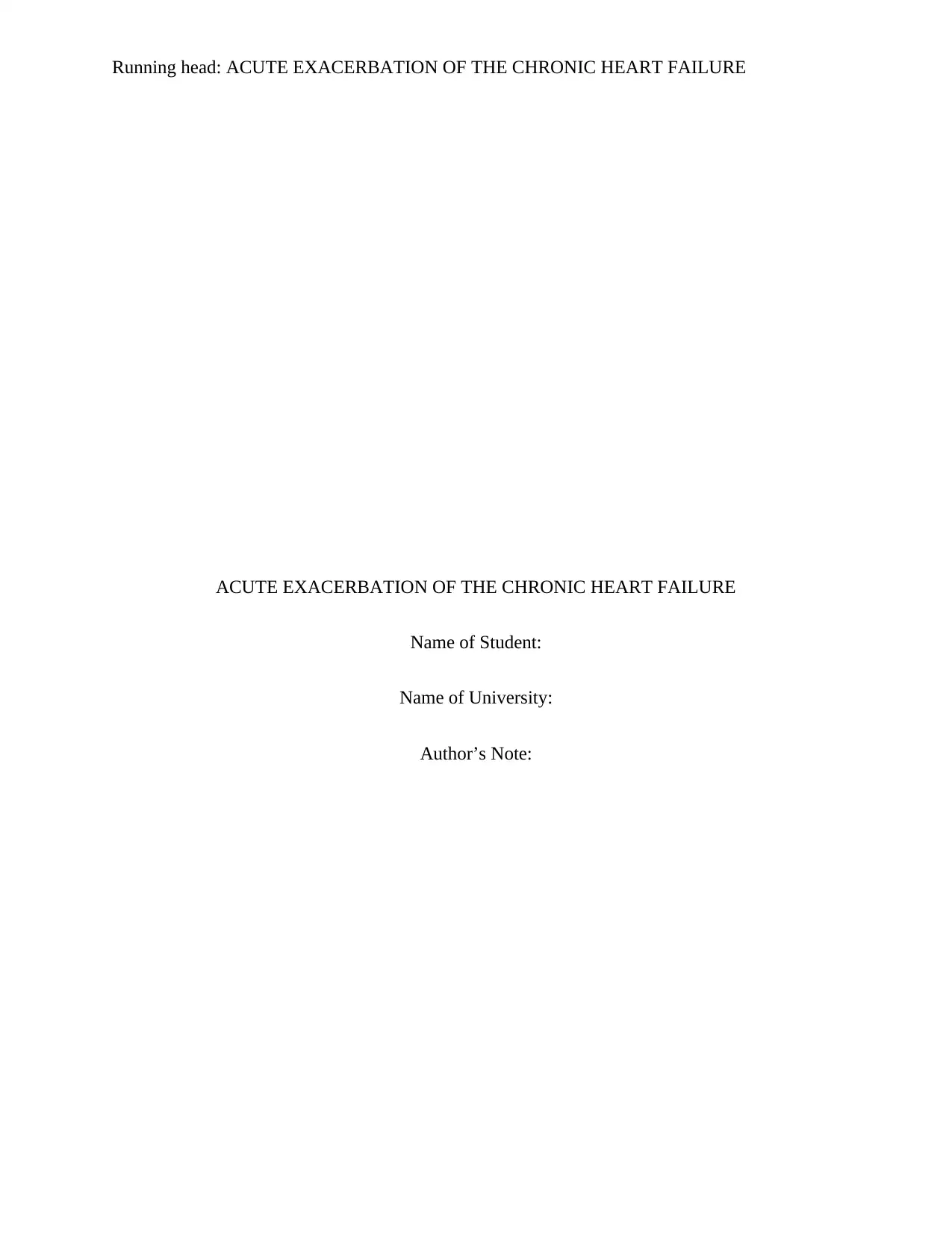
Running head: ACUTE EXACERBATION OF THE CHRONIC HEART FAILURE
ACUTE EXACERBATION OF THE CHRONIC HEART FAILURE
Name of Student:
Name of University:
Author’s Note:
ACUTE EXACERBATION OF THE CHRONIC HEART FAILURE
Name of Student:
Name of University:
Author’s Note:
Paraphrase This Document
Need a fresh take? Get an instant paraphrase of this document with our AI Paraphraser
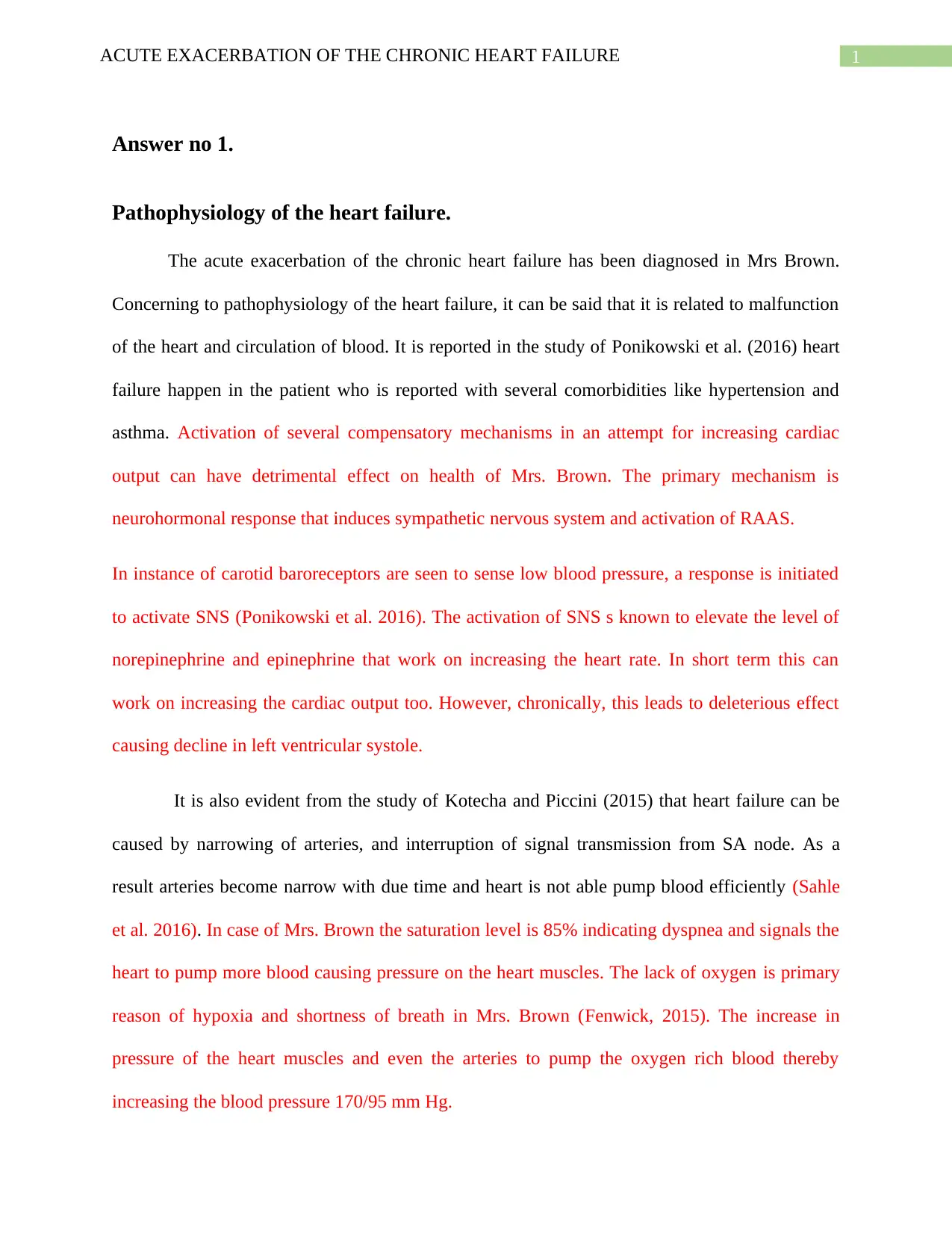
1ACUTE EXACERBATION OF THE CHRONIC HEART FAILURE
Answer no 1.
Pathophysiology of the heart failure.
The acute exacerbation of the chronic heart failure has been diagnosed in Mrs Brown.
Concerning to pathophysiology of the heart failure, it can be said that it is related to malfunction
of the heart and circulation of blood. It is reported in the study of Ponikowski et al. (2016) heart
failure happen in the patient who is reported with several comorbidities like hypertension and
asthma. Activation of several compensatory mechanisms in an attempt for increasing cardiac
output can have detrimental effect on health of Mrs. Brown. The primary mechanism is
neurohormonal response that induces sympathetic nervous system and activation of RAAS.
In instance of carotid baroreceptors are seen to sense low blood pressure, a response is initiated
to activate SNS (Ponikowski et al. 2016). The activation of SNS s known to elevate the level of
norepinephrine and epinephrine that work on increasing the heart rate. In short term this can
work on increasing the cardiac output too. However, chronically, this leads to deleterious effect
causing decline in left ventricular systole.
It is also evident from the study of Kotecha and Piccini (2015) that heart failure can be
caused by narrowing of arteries, and interruption of signal transmission from SA node. As a
result arteries become narrow with due time and heart is not able pump blood efficiently (Sahle
et al. 2016). In case of Mrs. Brown the saturation level is 85% indicating dyspnea and signals the
heart to pump more blood causing pressure on the heart muscles. The lack of oxygen is primary
reason of hypoxia and shortness of breath in Mrs. Brown (Fenwick, 2015). The increase in
pressure of the heart muscles and even the arteries to pump the oxygen rich blood thereby
increasing the blood pressure 170/95 mm Hg.
Answer no 1.
Pathophysiology of the heart failure.
The acute exacerbation of the chronic heart failure has been diagnosed in Mrs Brown.
Concerning to pathophysiology of the heart failure, it can be said that it is related to malfunction
of the heart and circulation of blood. It is reported in the study of Ponikowski et al. (2016) heart
failure happen in the patient who is reported with several comorbidities like hypertension and
asthma. Activation of several compensatory mechanisms in an attempt for increasing cardiac
output can have detrimental effect on health of Mrs. Brown. The primary mechanism is
neurohormonal response that induces sympathetic nervous system and activation of RAAS.
In instance of carotid baroreceptors are seen to sense low blood pressure, a response is initiated
to activate SNS (Ponikowski et al. 2016). The activation of SNS s known to elevate the level of
norepinephrine and epinephrine that work on increasing the heart rate. In short term this can
work on increasing the cardiac output too. However, chronically, this leads to deleterious effect
causing decline in left ventricular systole.
It is also evident from the study of Kotecha and Piccini (2015) that heart failure can be
caused by narrowing of arteries, and interruption of signal transmission from SA node. As a
result arteries become narrow with due time and heart is not able pump blood efficiently (Sahle
et al. 2016). In case of Mrs. Brown the saturation level is 85% indicating dyspnea and signals the
heart to pump more blood causing pressure on the heart muscles. The lack of oxygen is primary
reason of hypoxia and shortness of breath in Mrs. Brown (Fenwick, 2015). The increase in
pressure of the heart muscles and even the arteries to pump the oxygen rich blood thereby
increasing the blood pressure 170/95 mm Hg.

2ACUTE EXACERBATION OF THE CHRONIC HEART FAILURE
In the situation of heart failure, the whole mechanism of blood circulation is disturbed,
which is mainly influenced by the non-functioning of the cardiac cells. The outcome of such
affects the afterload and preload. According to Mentz and O'connor (2016) it can be reviewed
that afterload increase with increase in resistance of peripheral vascular which results in low
contraction of ventricles. The mechanism of contraction is altered when there is damage after
heart attack.
Heart failure is the consequence of two compensatory mechanisms, sympathetic nervous
system and renin angiotensin aldosterone system (RAAS) (Goldsmith, 2016). When heart
function is lowered, the RAAS system are activated and stimulates kidney to release renin, which
in turn causes release of angiotensin II. It is reported that angiotensin II and high level of
aldosterone causes vasoconstriction, high blood pressure and myocyte hypertrophy. They
increase the blood volume and cardiac output and damages the myocyte, thus resulting in fibrosis
and systolic heart failure.
Citing the instance of decrease in renal perfusion the kidney suspects hypovolemia.
Research conducted by Kotecha & Piccini (2015), provided the fact that low cardiac output can
limit renal perfusion. The mentioned compensatory mechanism can retain water and sodium for
RAAS. Angiotensin causes peripheral vasoconstriction, leading to rise in blood pressure of Mrs.
Brown.
Answer no 2.
Nursing strategy 1. To manage hypoxia and shortness of breath using Fowler position.
As reviewed from the case study, Mrs Brown was showing major sign for heart failure,
which includes severe dyspnoea, high rate of respiratory, low oxygen saturation level and atrial
In the situation of heart failure, the whole mechanism of blood circulation is disturbed,
which is mainly influenced by the non-functioning of the cardiac cells. The outcome of such
affects the afterload and preload. According to Mentz and O'connor (2016) it can be reviewed
that afterload increase with increase in resistance of peripheral vascular which results in low
contraction of ventricles. The mechanism of contraction is altered when there is damage after
heart attack.
Heart failure is the consequence of two compensatory mechanisms, sympathetic nervous
system and renin angiotensin aldosterone system (RAAS) (Goldsmith, 2016). When heart
function is lowered, the RAAS system are activated and stimulates kidney to release renin, which
in turn causes release of angiotensin II. It is reported that angiotensin II and high level of
aldosterone causes vasoconstriction, high blood pressure and myocyte hypertrophy. They
increase the blood volume and cardiac output and damages the myocyte, thus resulting in fibrosis
and systolic heart failure.
Citing the instance of decrease in renal perfusion the kidney suspects hypovolemia.
Research conducted by Kotecha & Piccini (2015), provided the fact that low cardiac output can
limit renal perfusion. The mentioned compensatory mechanism can retain water and sodium for
RAAS. Angiotensin causes peripheral vasoconstriction, leading to rise in blood pressure of Mrs.
Brown.
Answer no 2.
Nursing strategy 1. To manage hypoxia and shortness of breath using Fowler position.
As reviewed from the case study, Mrs Brown was showing major sign for heart failure,
which includes severe dyspnoea, high rate of respiratory, low oxygen saturation level and atrial
⊘ This is a preview!⊘
Do you want full access?
Subscribe today to unlock all pages.

Trusted by 1+ million students worldwide
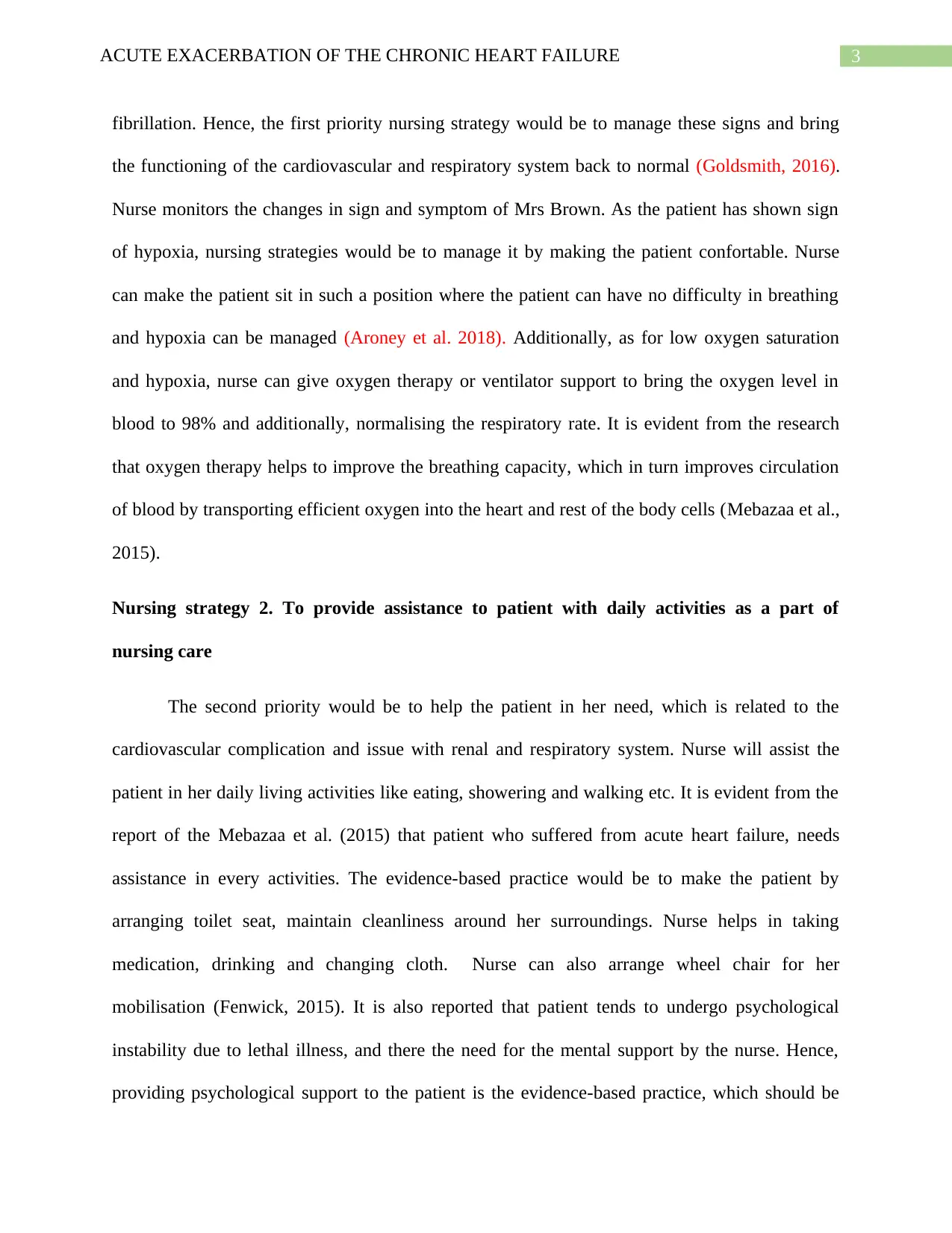
3ACUTE EXACERBATION OF THE CHRONIC HEART FAILURE
fibrillation. Hence, the first priority nursing strategy would be to manage these signs and bring
the functioning of the cardiovascular and respiratory system back to normal (Goldsmith, 2016).
Nurse monitors the changes in sign and symptom of Mrs Brown. As the patient has shown sign
of hypoxia, nursing strategies would be to manage it by making the patient confortable. Nurse
can make the patient sit in such a position where the patient can have no difficulty in breathing
and hypoxia can be managed (Aroney et al. 2018). Additionally, as for low oxygen saturation
and hypoxia, nurse can give oxygen therapy or ventilator support to bring the oxygen level in
blood to 98% and additionally, normalising the respiratory rate. It is evident from the research
that oxygen therapy helps to improve the breathing capacity, which in turn improves circulation
of blood by transporting efficient oxygen into the heart and rest of the body cells (Mebazaa et al.,
2015).
Nursing strategy 2. To provide assistance to patient with daily activities as a part of
nursing care
The second priority would be to help the patient in her need, which is related to the
cardiovascular complication and issue with renal and respiratory system. Nurse will assist the
patient in her daily living activities like eating, showering and walking etc. It is evident from the
report of the Mebazaa et al. (2015) that patient who suffered from acute heart failure, needs
assistance in every activities. The evidence-based practice would be to make the patient by
arranging toilet seat, maintain cleanliness around her surroundings. Nurse helps in taking
medication, drinking and changing cloth. Nurse can also arrange wheel chair for her
mobilisation (Fenwick, 2015). It is also reported that patient tends to undergo psychological
instability due to lethal illness, and there the need for the mental support by the nurse. Hence,
providing psychological support to the patient is the evidence-based practice, which should be
fibrillation. Hence, the first priority nursing strategy would be to manage these signs and bring
the functioning of the cardiovascular and respiratory system back to normal (Goldsmith, 2016).
Nurse monitors the changes in sign and symptom of Mrs Brown. As the patient has shown sign
of hypoxia, nursing strategies would be to manage it by making the patient confortable. Nurse
can make the patient sit in such a position where the patient can have no difficulty in breathing
and hypoxia can be managed (Aroney et al. 2018). Additionally, as for low oxygen saturation
and hypoxia, nurse can give oxygen therapy or ventilator support to bring the oxygen level in
blood to 98% and additionally, normalising the respiratory rate. It is evident from the research
that oxygen therapy helps to improve the breathing capacity, which in turn improves circulation
of blood by transporting efficient oxygen into the heart and rest of the body cells (Mebazaa et al.,
2015).
Nursing strategy 2. To provide assistance to patient with daily activities as a part of
nursing care
The second priority would be to help the patient in her need, which is related to the
cardiovascular complication and issue with renal and respiratory system. Nurse will assist the
patient in her daily living activities like eating, showering and walking etc. It is evident from the
report of the Mebazaa et al. (2015) that patient who suffered from acute heart failure, needs
assistance in every activities. The evidence-based practice would be to make the patient by
arranging toilet seat, maintain cleanliness around her surroundings. Nurse helps in taking
medication, drinking and changing cloth. Nurse can also arrange wheel chair for her
mobilisation (Fenwick, 2015). It is also reported that patient tends to undergo psychological
instability due to lethal illness, and there the need for the mental support by the nurse. Hence,
providing psychological support to the patient is the evidence-based practice, which should be
Paraphrase This Document
Need a fresh take? Get an instant paraphrase of this document with our AI Paraphraser
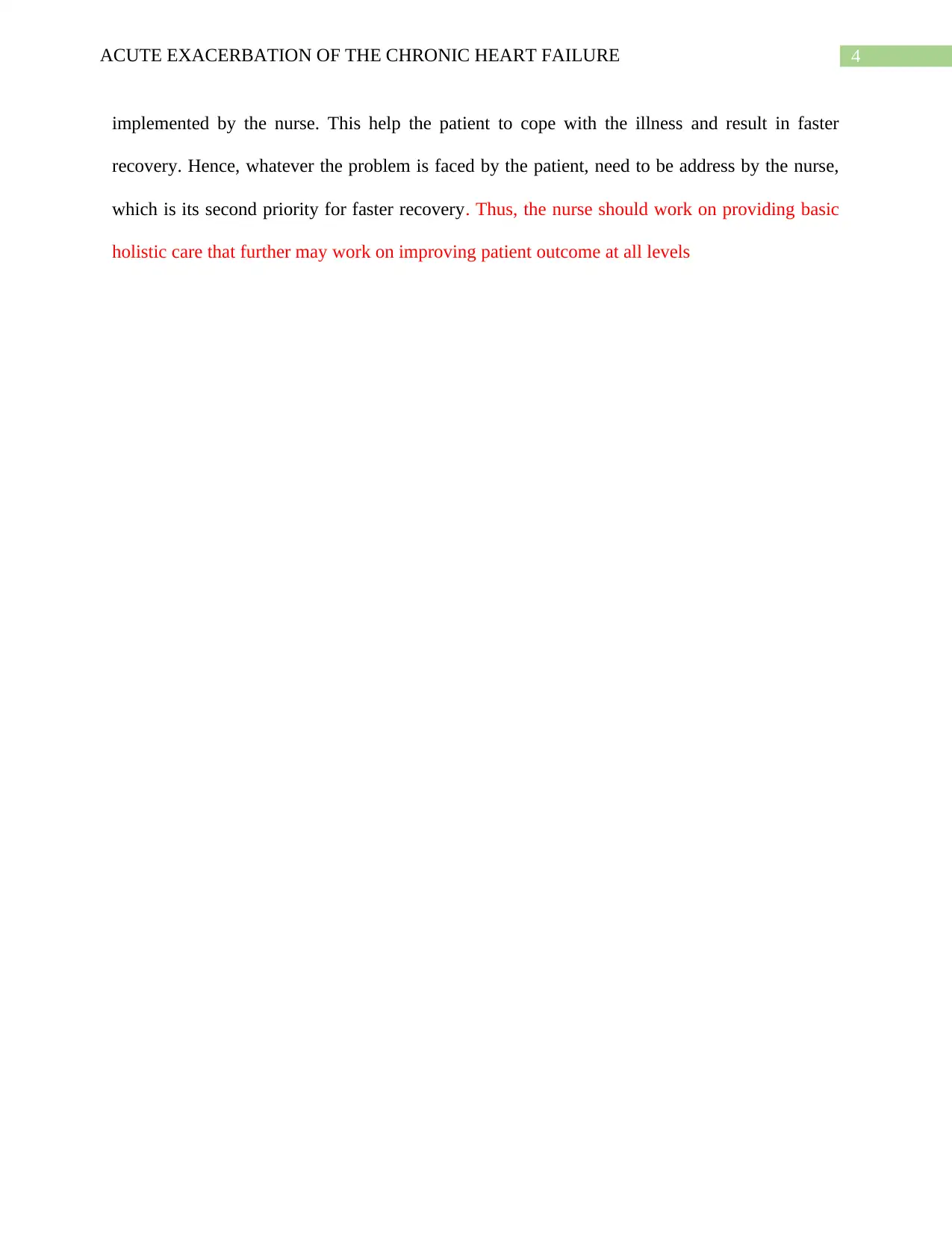
4ACUTE EXACERBATION OF THE CHRONIC HEART FAILURE
implemented by the nurse. This help the patient to cope with the illness and result in faster
recovery. Hence, whatever the problem is faced by the patient, need to be address by the nurse,
which is its second priority for faster recovery. Thus, the nurse should work on providing basic
holistic care that further may work on improving patient outcome at all levels
implemented by the nurse. This help the patient to cope with the illness and result in faster
recovery. Hence, whatever the problem is faced by the patient, need to be address by the nurse,
which is its second priority for faster recovery. Thus, the nurse should work on providing basic
holistic care that further may work on improving patient outcome at all levels
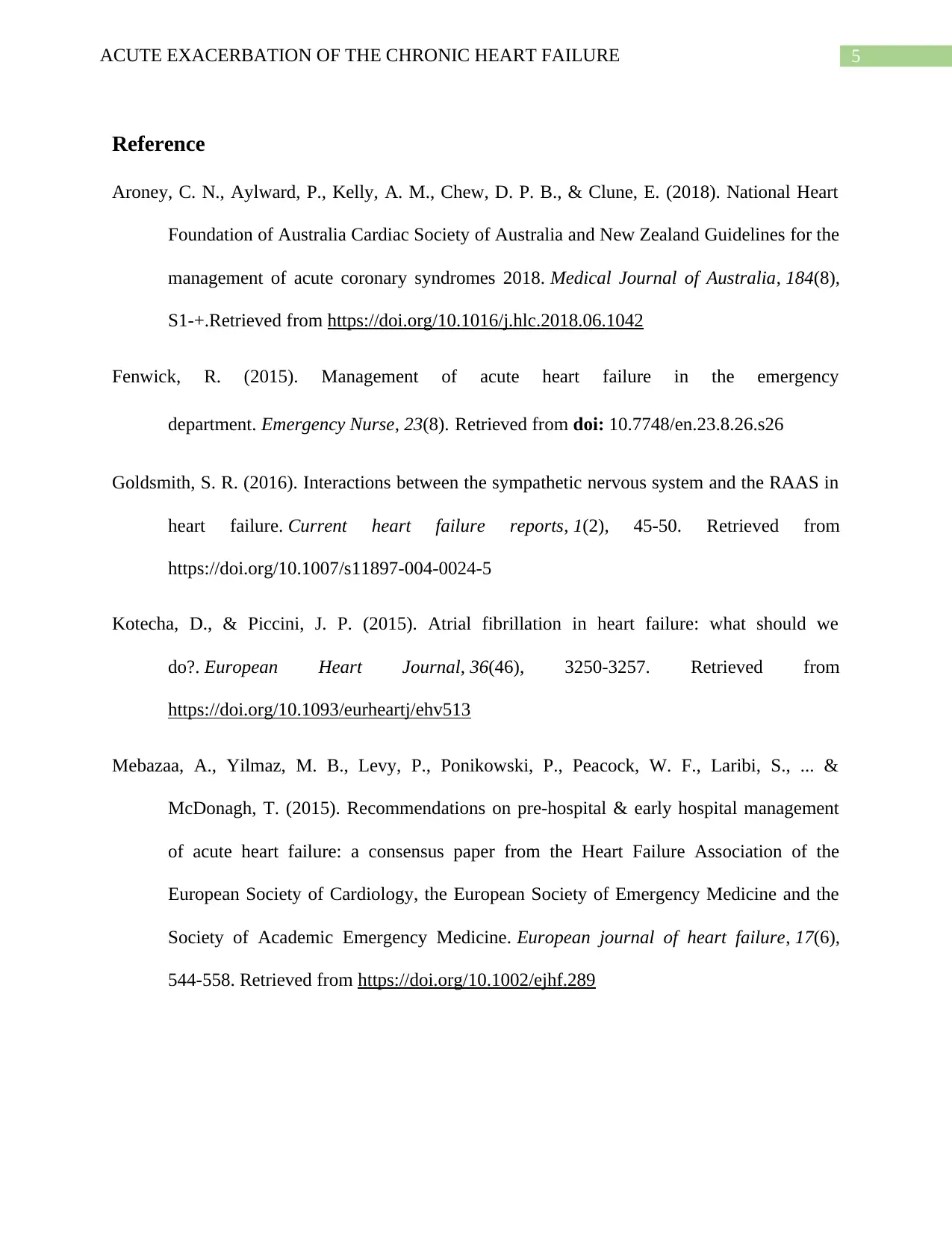
5ACUTE EXACERBATION OF THE CHRONIC HEART FAILURE
Reference
Aroney, C. N., Aylward, P., Kelly, A. M., Chew, D. P. B., & Clune, E. (2018). National Heart
Foundation of Australia Cardiac Society of Australia and New Zealand Guidelines for the
management of acute coronary syndromes 2018. Medical Journal of Australia, 184(8),
S1-+.Retrieved from https://doi.org/10.1016/j.hlc.2018.06.1042
Fenwick, R. (2015). Management of acute heart failure in the emergency
department. Emergency Nurse, 23(8). Retrieved from doi: 10.7748/en.23.8.26.s26
Goldsmith, S. R. (2016). Interactions between the sympathetic nervous system and the RAAS in
heart failure. Current heart failure reports, 1(2), 45-50. Retrieved from
https://doi.org/10.1007/s11897-004-0024-5
Kotecha, D., & Piccini, J. P. (2015). Atrial fibrillation in heart failure: what should we
do?. European Heart Journal, 36(46), 3250-3257. Retrieved from
https://doi.org/10.1093/eurheartj/ehv513
Mebazaa, A., Yilmaz, M. B., Levy, P., Ponikowski, P., Peacock, W. F., Laribi, S., ... &
McDonagh, T. (2015). Recommendations on pre‐hospital & early hospital management
of acute heart failure: a consensus paper from the Heart Failure Association of the
European Society of Cardiology, the European Society of Emergency Medicine and the
Society of Academic Emergency Medicine. European journal of heart failure, 17(6),
544-558. Retrieved from https://doi.org/10.1002/ejhf.289
Reference
Aroney, C. N., Aylward, P., Kelly, A. M., Chew, D. P. B., & Clune, E. (2018). National Heart
Foundation of Australia Cardiac Society of Australia and New Zealand Guidelines for the
management of acute coronary syndromes 2018. Medical Journal of Australia, 184(8),
S1-+.Retrieved from https://doi.org/10.1016/j.hlc.2018.06.1042
Fenwick, R. (2015). Management of acute heart failure in the emergency
department. Emergency Nurse, 23(8). Retrieved from doi: 10.7748/en.23.8.26.s26
Goldsmith, S. R. (2016). Interactions between the sympathetic nervous system and the RAAS in
heart failure. Current heart failure reports, 1(2), 45-50. Retrieved from
https://doi.org/10.1007/s11897-004-0024-5
Kotecha, D., & Piccini, J. P. (2015). Atrial fibrillation in heart failure: what should we
do?. European Heart Journal, 36(46), 3250-3257. Retrieved from
https://doi.org/10.1093/eurheartj/ehv513
Mebazaa, A., Yilmaz, M. B., Levy, P., Ponikowski, P., Peacock, W. F., Laribi, S., ... &
McDonagh, T. (2015). Recommendations on pre‐hospital & early hospital management
of acute heart failure: a consensus paper from the Heart Failure Association of the
European Society of Cardiology, the European Society of Emergency Medicine and the
Society of Academic Emergency Medicine. European journal of heart failure, 17(6),
544-558. Retrieved from https://doi.org/10.1002/ejhf.289
⊘ This is a preview!⊘
Do you want full access?
Subscribe today to unlock all pages.

Trusted by 1+ million students worldwide
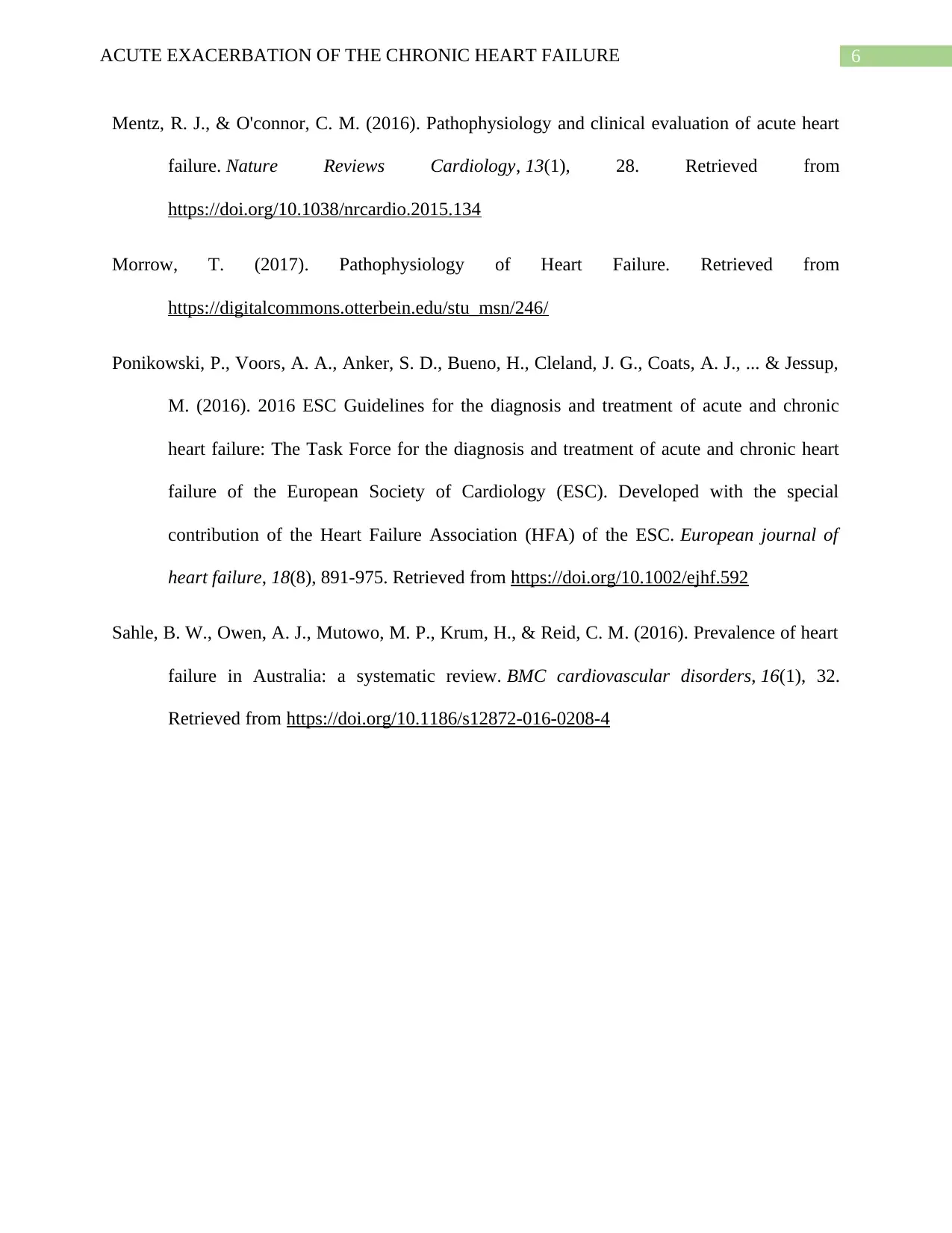
6ACUTE EXACERBATION OF THE CHRONIC HEART FAILURE
Mentz, R. J., & O'connor, C. M. (2016). Pathophysiology and clinical evaluation of acute heart
failure. Nature Reviews Cardiology, 13(1), 28. Retrieved from
https://doi.org/10.1038/nrcardio.2015.134
Morrow, T. (2017). Pathophysiology of Heart Failure. Retrieved from
https://digitalcommons.otterbein.edu/stu_msn/246/
Ponikowski, P., Voors, A. A., Anker, S. D., Bueno, H., Cleland, J. G., Coats, A. J., ... & Jessup,
M. (2016). 2016 ESC Guidelines for the diagnosis and treatment of acute and chronic
heart failure: The Task Force for the diagnosis and treatment of acute and chronic heart
failure of the European Society of Cardiology (ESC). Developed with the special
contribution of the Heart Failure Association (HFA) of the ESC. European journal of
heart failure, 18(8), 891-975. Retrieved from https://doi.org/10.1002/ejhf.592
Sahle, B. W., Owen, A. J., Mutowo, M. P., Krum, H., & Reid, C. M. (2016). Prevalence of heart
failure in Australia: a systematic review. BMC cardiovascular disorders, 16(1), 32.
Retrieved from https://doi.org/10.1186/s12872-016-0208-4
Mentz, R. J., & O'connor, C. M. (2016). Pathophysiology and clinical evaluation of acute heart
failure. Nature Reviews Cardiology, 13(1), 28. Retrieved from
https://doi.org/10.1038/nrcardio.2015.134
Morrow, T. (2017). Pathophysiology of Heart Failure. Retrieved from
https://digitalcommons.otterbein.edu/stu_msn/246/
Ponikowski, P., Voors, A. A., Anker, S. D., Bueno, H., Cleland, J. G., Coats, A. J., ... & Jessup,
M. (2016). 2016 ESC Guidelines for the diagnosis and treatment of acute and chronic
heart failure: The Task Force for the diagnosis and treatment of acute and chronic heart
failure of the European Society of Cardiology (ESC). Developed with the special
contribution of the Heart Failure Association (HFA) of the ESC. European journal of
heart failure, 18(8), 891-975. Retrieved from https://doi.org/10.1002/ejhf.592
Sahle, B. W., Owen, A. J., Mutowo, M. P., Krum, H., & Reid, C. M. (2016). Prevalence of heart
failure in Australia: a systematic review. BMC cardiovascular disorders, 16(1), 32.
Retrieved from https://doi.org/10.1186/s12872-016-0208-4
1 out of 7
Related Documents
Your All-in-One AI-Powered Toolkit for Academic Success.
+13062052269
info@desklib.com
Available 24*7 on WhatsApp / Email
![[object Object]](/_next/static/media/star-bottom.7253800d.svg)
Unlock your academic potential
Copyright © 2020–2025 A2Z Services. All Rights Reserved. Developed and managed by ZUCOL.





